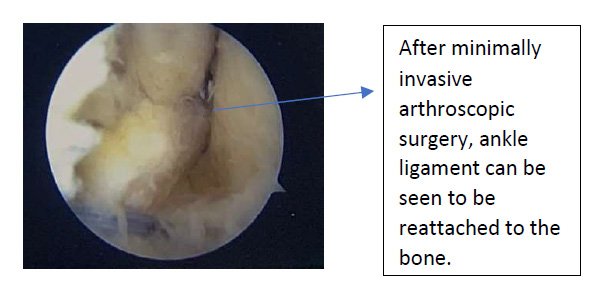What you should know?

Ankle sprains account for up to 30% of injuries in most sports.
A sprained ankle is one of the most common injuries seen in the foot and ankle clinic or in the sports arena. This type of injury occurs when the ankle rolls outwards (inversion) during activities such as landing from a jump, side stepping or simply walking on uneven ground. Sometimes you may feel a crack or tear sensation followed by swelling and bruising around the outside of your ankle and it may be difficult to walk on.
Let’s have a look at how you can manage a sprained ankle and how you can prevent your ankle from being chronically unstable.
When walking and running etc these ligaments contribute to the stability of the ankle and prevent it from rolling outwards. When this mechanism fails the ligaments are stretched and may partially tear and if stretched far enough will eventually completely tear or rupture.

How bad is my ankle sprain?
Ankle sprains are generally classified into 3 grades:
Grade 1: minor micro-tearing of ligament fibres. Can often return to full activity in 1-3 weeks.
Grade 2: significant but incomplete tearing of the ligament. Normally requires 4-6 weeks rehabilitation prior to full activity.
Grade 3: the rupture of the ligament. This may require surgery and can also result in fractures around the ankle joint. Recovery can range from 6-12 weeks.
What can I do to manage my sprained ankle?
R.I.C.E.– Initially it is important to Rest, Ice, Compress and Elevate the ankle to minimise swelling and bruising and prevent any further damage. Depending on the severity of the injury or if symptoms linger for more than a week, it is good to get the ankle assessed by an orthopaedic surgeon. Sometimes if you are unable to even walk due to severe pain in the ankle after the injury, having an X-ray done is wise to exclude any ankle fractures. Wearing an ankle brace or a walker boot in the initial period may be useful for pain relief and to allow limited mobility.
Move – Once pain allows it is important to begin movement of the injured ankle. Early movement has been shown to reduce the rates of long-term issues with joint pain and stiffness. This may begin by gradually increasing walking as well as simple exercises such as ankle pumps before incorporating a range of exercises to regain full range of motion.
Muscle conditioning – following ankle injury it is important to strengthen the muscles surrounding the ankle to allow for better stability of the joint reducing the chance for injury in the future.

Poor rehabilitation
There are a number of factors described above which are vital to fully rehabilitate the ankle. By simply waiting until the ankle ‘feels’ better before returning to activity you put yourself at risk of re-injury.
Returning to sport too early
You are more likely to re-sprain your ankle within 12 months of the initial injury, therefore by returning to sport or activity before the ankle has full strength, range of motion and is stable during dynamic movement there is even greater risk of re-injury.

Proprioception – describes receptors in the body’s ligaments which send information to tell the brain where a joint is in space. For example, as the ankle starts to roll outwards these receptors will let the brain know this is happening to then make sure the ankle is rolled back into a normal position. Studies show that during ligamentous injury proprioceptors are damaged and need re-training to prevent further injury. This can include exercises such as single leg balance, standing on uneven surfaces, hopping, jumping and sidestepping.
Functional exercises – once you are pain free and have full range of motion it is vital to begin functional re-training. This may include sportsspecific exercise, running and jumping.
What causes Chronic Ankle Instability and what can I do to avoid it?

In a number of ankle sprains there can be ongoing symptoms such as pain, recurrent instability, swelling after exercise and impaired function greater than 6 weeks post injury. This can be explained by the following:
Poor rehabilitation
There are a number of factors described above which are vital to fully rehabilitate the ankle. By simply waiting until the ankle ‘feels’ better before returning to activity you put yourself at risk of re-injury.
Returning to sport too early
You are more likely to re-sprain your ankle within 12 months of the initial injury, therefore by returning to sport or activity before the ankle has full strength, range of motion and is stable during dynamic movement there is even greater risk of re-injury.

Poor proprioception
As described above this is a key factor to preventing further injury in ankles. A physiotherapist can assess and prescribe a number of exercises to specifically target this area. So the next time you sprain your ankle and if it does not improve after conservative measures after a week, it is best to consult an orthopaedic surgeon for a more complete assessment.
Arthroscopic ankle ligament surgery
When an ankle is unstable and not responding to physiotherapy, or if an unstable ankle has evidence of cartilage injury, your surgeon will recommend surgery to stabilise the ankle ligaments to prevent further cartilage injury. During the same time, the existing cartilage injury can also be addressed. With recent advances, ankle ligament surgeries and cartilage repair procedures can be performed arthroscopically (minimally invasive techniques).

These surgeries can be done as a day surgery procedure and your orthopaedic surgeon will discuss the rehabilitation program based on the severity of your injury. Do not hesitate to evaluate a painful ankle sprain that does not improve within a week to avoid future complications.

- Consultant Orthopaedic Surgeon
- Specialist in Orthopaedic Sports Medicine







